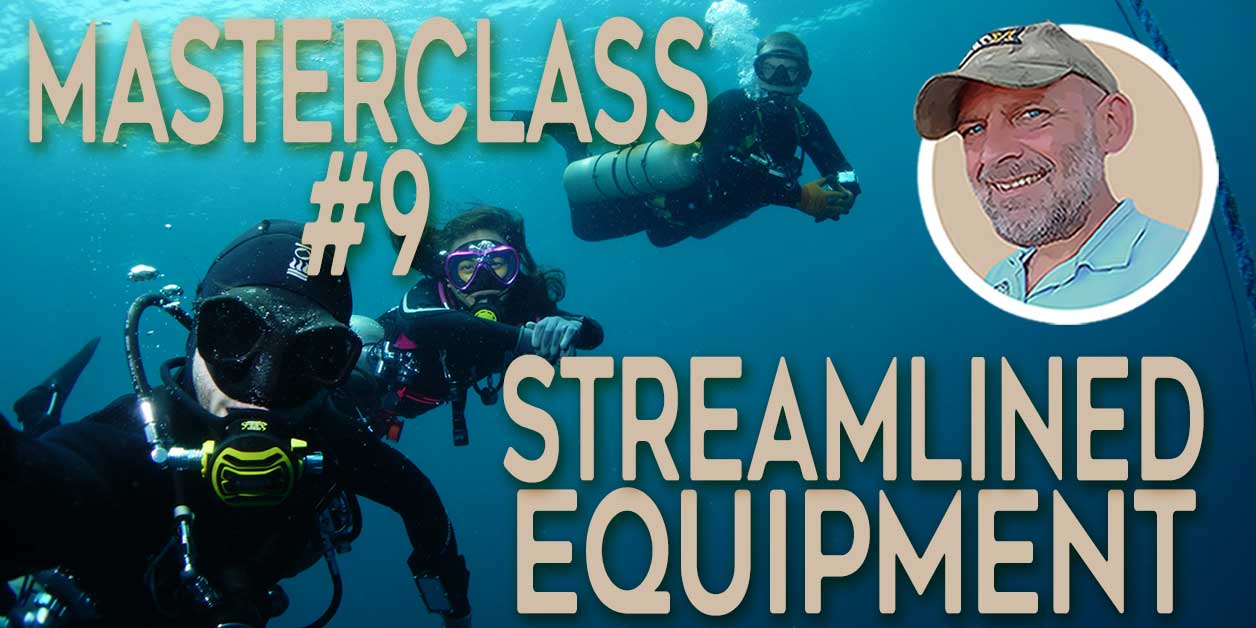Ultimate Pro Guide To Buying Scuba Diving Fins
Picking the right diving fins has a profound effect on the quality of your scuba diving experience. However, it can be difficult to decide your best option when navigating bold manufacturer claims and the vested interests of dive gear salespeople.
This comprehensive guide aims to clarify the confusion and assist you with choosing a set of fins that you won’t regret buying later on.
As a full-time diving instructor for over half of my adult life, I’ve had the opportunity to learn a lot about diving fins; what’s good, what’s bad, and what is diver-specific. As always in this blog, my aim is to share what I have learned from experience.
What I will share in this article:
- The Importance of Good Diving Fins: Uncover why your choice of diving fins is crucial to provide enhanced propulsion, maneuverability, energy conservation, and overall physical efficiency on your dives.
- How Do Diving Fins Work? Learn how diving fins utilize physics to transform leg movement into underwater propulsion.
- The Basic Features of Diving Fins: Explore the significance of fin blade surface area, material rigidity and flexibility, foot pocket support and comfort, and those factors impact on fin performance.
- Open Heel versus Full Foot Fins: Compare the pros and cons of open heel and full foot fins.
- Paddle, Jet, and Split Fins: Examine the unique characteristics of the three most common fin designs: paddle, jet, and split fins.
- Choosing the Right Fin: What individual factors may apply when determining the best diving fin for your current and future needs?
Keep reading to learn invaluable facts and advice about diving fins that will save you from regrettable mistakes, stressful dives, and wasted money!
Why are diving fins important?
Diving fins are an indispensable part of a scuba diver’s equipment. They serve several important purposes that greatly enhance the diving experience. Here’s a closer look at why diving fins are crucial for every diver:
Increased Propulsion
- Diving fins increase the surface area of your feet, generating more thrust with each kick cycle.
- Efficient propulsion conserves energy and reduces fatigue during dives.
- More propulsion allows for greater distances to be covered and more extensive exploration during dives.
Improved Maneuverability
- Fins allow you to control your positioning and orientation.
- Enhanced control keeps buddy teams together, helps you spot more underwater creatures, and react more effectively to emergencies.
- Improved fine control is beneficial in precise maneuvering; an essential ability for underwater photographers, videographers, cave and wreck divers.
Efficient Energy Conservation
- Diving fins optimize energy expenditure by reducing the effort required for covering a given distance.
- Reduced physical exertion will reduce your air consumption.
- Energy conservation ensures a more comfortable and enjoyable diving experience.
Safety and Emergency Situations
- Fins aid in maintaining control when dealing with strong currents and surges.
- They assist with effective responses during emergencies or when assisting others.
- A good set of diving fins provide an added layer of safety and confidence for divers in various situations.
The Physics of How Diving Fins Work
Diving fins are designed to generate forward propulsion or thrust by taking advantage of water resistance. Whether it’s animals, watercraft, or swimmers, the principle remains the same. Water exerts resistance against objects moving through it, and this resistance can be harnessed to create propulsion.
For every action (force) in nature there is an equal and opposite reaction. If an object A (a scuba diver) exerts a force on object B (the water), then object B must exert a force of equal magnitude and opposite direction back on object A.
Newton’s 3rd Law of Motion – paraphrased for divers.
Resistance and Thrust
- During a flutter kick, the legs generate propulsion by pushing the water off and around the feet, creating thrust.
- Newton’s Third Law explains that the force exerted by the legs pushing water backward results in a corresponding force pushing the scuba diver forward.
- Unlike animals with webbed feet, the human foot is not well-suited for moving large amounts of water efficiently.
- Increasing the surface area of the feet, similar to the webbed feet of frogs or the flippers of sea lions, can help generate more thrust during kicks.
How Diving Fins Optimize Thrust Efficiency
- Thrust efficiency measures the conversion of kicking energy into forward movement during swimming.
- It represents the ratio of the useful or effective thrust produced to the input energy or power expended.
- The higher the thrust efficiency, the more effectively the propulsion system converts energy into forward movement
- Diving fin engineers can modify variables such as blade length, shape, and stiffness to enhance thrust efficiency.
- Thrust efficiency varies among individuals due to factors like:
- Cardiovascular fitness
- Leg strength and muscular endurance
- Kicking style
- The diving equipment used
- Streamlining of the diver and their gear
- Choosing diving fins that match your skill level, physical capabilities, and intended use is essential for maximizing thrust efficiency.
The Reality of Physical Effort Versus Propulsion
- The (muscular) energy moving against water resistance equals the amount of propulsion achieved.
- More energy expenditure by the diver means more propulsion.
- Less energy expenditure per kick cycle demands more kick cycles to cover a given distance.
- Fewer high-energy kick cycles equal more low-energy kick cycles for the same propulsion.
- Diving fins are not more or less ‘efficient’, but rather deliver comparable propulsion depending on the trade-off between kick cycle speed and effort.
- Fins that claim greater efficiency due to the elastic ‘snap-back’ of fin blades overlook the reality that the elastic tension nonetheless requires exertion to load on the blade.
In short, there is no avoiding a level of physical exertion to cover a given distance underwater in a given time. However, divers may have a personal preference whether they make a greater number of easier kick cycles, or whether they prefer a fewer number of more effortful kicks. That preference may be determined by their stamina and strength, intended acceleration, finning speed, and streamlining, coupled with the refinement of their propulsion technique.
Factors Affecting Diving Fin Performance
- Leg Strength, Cardiovascular Fitness and Finning Technique: Stiffer fins are suitable for those with strong legs, higher muscular endurance, and efficient finning technique.
- Equipment Loading: Advanced-level divers require stiffer, more powerful, fins to accommodate heavier and more bulky equipment.
- Streamlining: Moving in horizontal trim and neatly configured diving gear reduces the thrust that fins need to produce.
- Blade Length: Longer fins generate more thrust and can move more water with each kick. However, they may be less maneuverable and pose challenges in confined spaces.
- Stiffness: Fins need to strike a balance between stiffness and flexibility. Stiffer blades offer more thrust but require greater leg strength, while too much flexibility results in limited thrust.
Diving Fin Materials
- Materials used in fin construction affect stiffness and buoyancy characteristics.
- Modern fins commonly use silicones and thermoplastic elastomers, providing a specified level of rigidity and comfortable foot pockets.
Understanding the physics behind diving fins helps you select the right fin type and maximize propulsion efficiency in various water activities. By considering factors such as leg strength, equipment weight, and blade length, you can choose swim fins that best suit your needs and enhance your swimming experience.
Key Factors When Considering Buying Diving Fins
When choosing diving fins, several key factors should be taken into account to ensure optimal performance and comfort underwater. Here are the main factors to consider:
Surface Area
The surface area of the diving fins plays a crucial role in generating propulsion and determining the efficiency of your kicks. Consider the following:
- A larger surface area creates more resistance against the water, resulting in greater thrust and control.
- Excessively large fins may require more effort to kick and can cause fatigue.
- Fins with vents and splits reduce the effect of surface area.
- Smaller surface areas, vents, and splits reduce muscular exertion but typically offer less thrust.
- Find the right balance based on your diving style, water conditions, and physical strength.
Material Rigidity and Flexibility
The materials used in fin construction greatly influence their rigidity and flexibility. Take into account the following:
- Stiffer fins produce more thrust and increase maneuverability.
- More flexible fins reduce your physical exertion at the cost of thrust and maneuvering ability.
- Be realistic about your cardiovascular fitness and the muscular endurance of your legs.
- Stiff fins become far more manageable if efficient finning techniques are improved.
Fin Buoyancy
Consider the buoyancy characteristics of the diving fins:
- Fins are available with different materials that create either neutral, negative, or positive buoyancy.
- Fin buoyancy can have a profound influence on your diving trim, as the buoyancy characteristics are applied at the end of a long lever (the legs).
- Foot-heavy divers may benefit from neutrally or positively buoyant fins.
- Foot-light divers may benefit from negatively buoyant fins.
- Negatively buoyant fins are typically popular with drysuit divers, as they help counterbalance the effect of gas in the lower legs and boots.
Foot Pocket Support and Comfort
Evaluate the foot pocket design and comfort of the diving fins:
- Look for well-designed foot pockets that securely hold your feet in place and provide ample support.
- The foot pocket should fit snugly but not be too tight, allowing for easy entry and exit while preventing excessive movement.
- Consider how the shape and size of the foot pocket work with the booties you will actually use on your dives.
- Foot pockets with rigid and extended side walls can offer greater control when performing advanced maneuvering techniques; such as frog kick, back kick, and helicopter turns.
To make an informed decision when purchasing diving fins, consider these key factors and evaluate how they align with your diving style, preferences, and intended use. Finding the right combination of surface area, material rigidity and flexibility, fin buoyancy, and foot pocket support will contribute to a more enjoyable and efficient diving experience.
Choosing Your Diving Fins: Open Heel versus Full Foot Fin Styles
When buying diving fins, your first fundamental decision is the style of the fin. There are two primary styles of diving fins to consider: open-heel and full-foot fins. Each style has its advantages and considerations, and choosing the right one depends on your diving needs and preferences. Here are the differences and benefits of each style:
Open Heel Fins
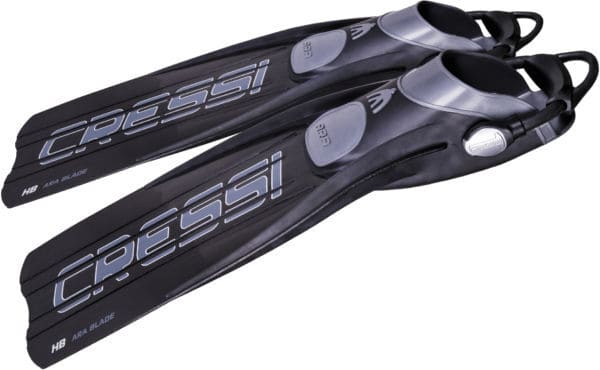
Open-heel fins have a foot pocket design that is designed to work with diving booties. Here are the pros and cons of open-heel fins:
Open Heel Fin Pros:
- Versatility: The adjustable straps allow for a customizable fit, accommodating various thicknesses of dive booties.
- Boot Compatibility: Open-heel fins can be worn with neoprene booties, providing thermal insulation and protection.
- Easy Donning and Doffing: The open-heel design enables quick and effortless entry and removal of the fins.
- Greater Thrust and Control: Open-heel fin designs typically feature a larger blade area that offers more power and control for the diver.
Open Heel Fin Cons:
- Bulkier and Heavier Design: Open-heel fins tend to be bulkier and less compact for travel.
- Additional Gear: Wearing booties with open-heel fins requires extra equipment, which can be a disadvantage for dive vacation travel.
Open-heel fins are well-suited for divers who prioritize versatility, adjustable fit, and compatibility with booties. They are ideal for cold-water diving, as they can accommodate thicker neoprene booties or dry boots to provide insulation in chilly environments.
The ability to use dive booties is especially beneficial for divers who perform shore entries, In these situations, booties provide foot protection when walking over sharp rocks or hot sand. For very rough surfaces, hard-soled booties are a good option.
Additionally, open-heel fins are suitable for divers who prefer the ability to fine-tune the fit and easily adjust their equipment during the dive.
Full Foot Fins
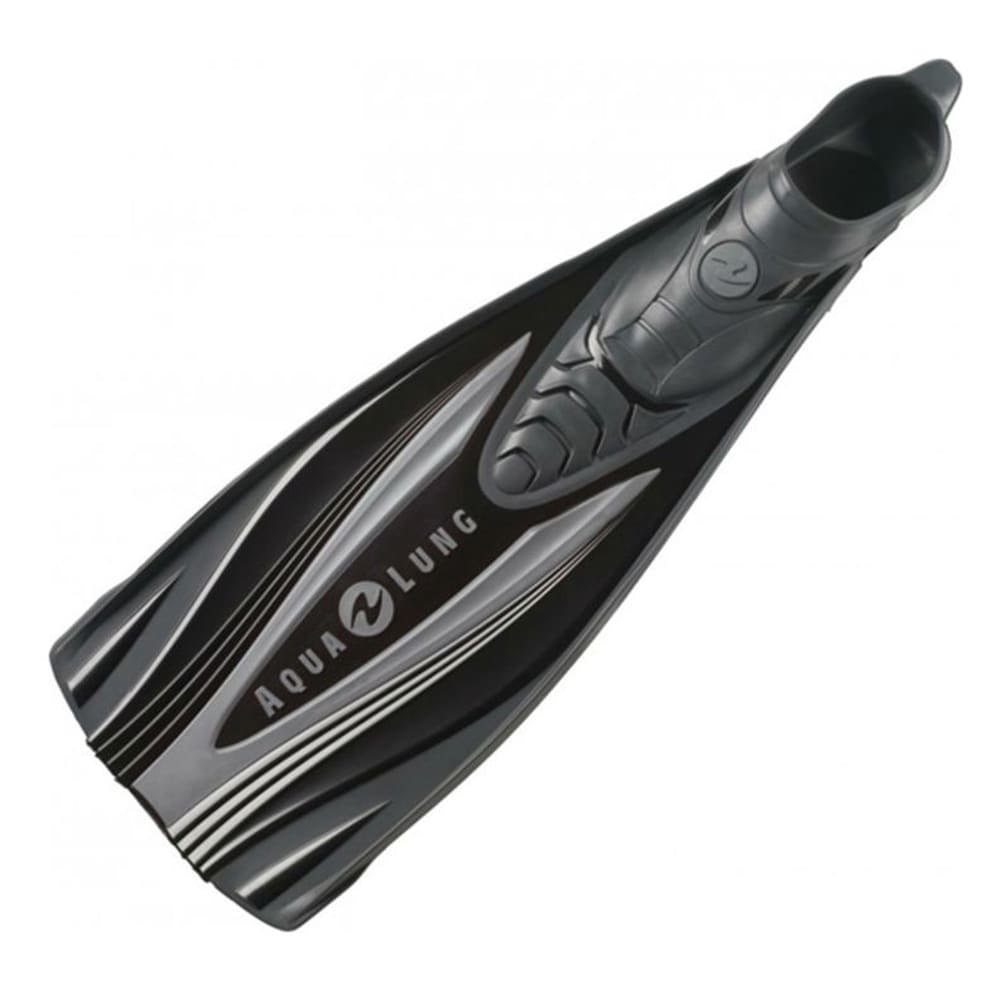
Full-foot fins, also known as closed-heel fins, have a closed-foot pocket design and are worn directly on bare feet or with thin neoprene socks. Consider the following pros and cons of full-foot fins:
Full Foot Fin Pros:
- Lightweight and Low Bulk Design: Full-foot fins are compact and lightweight, making them convenient for travel and snorkeling.
- Simplicity: Full-foot fins are easy to put on and take off, requiring minimal adjustment during the dive.
Full Foot Fin Cons:
- No Size Adjustability: Full foot fins have fixed sizes, which may not accommodate various foot shapes or sizes.
- No Boot Compatibility: These fins are not suitable for wearing with neoprene booties.
- No Thermal Protection: Without booties, full-foot fins offer no insulation in cooler waters.
- Less Thrust and Control: Full-foot typically have less rigidity and smaller blade size than open-heeled fins.
Full-foot fins are ideal for snorkelers, occasional tropical water divers, and those seeking the most compact and lightweight dive travel option. However, they are typically less capable than open-heeled fins and are very limited in their range of use.
Consider your diving preferences, water temperature, and intended use when deciding between open-heel and full-foot fins. Both styles offer unique advantages, and selecting the right fin style will enhance your comfort and performance in the water.
Understanding Fin Designs: Paddle, Jet, and Split Fins
Once you have decided on which fin style is best for your needs, the next decision is on the fin design. There are 3 essential designs available; Jet, Paddle, and Split fins.
Each design offers unique characteristics and benefits, catering to different diving needs and preferences. Let’s explore the differences and advantages of each fin style:
Paddle Fins
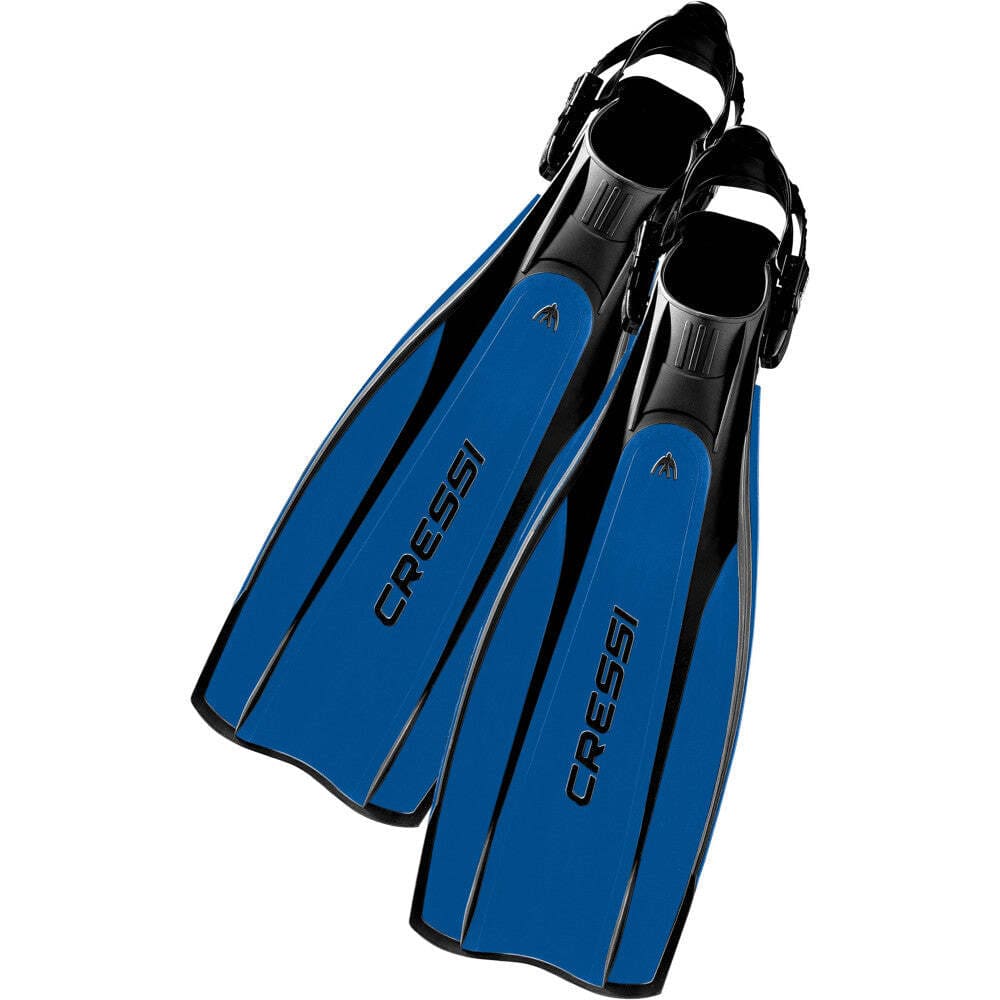
Paddle fins are the most basic design, and tend to be the most economical to buy. They are typically what divers are rented by dive centers for open water courses. Here are the pros and cons of paddle fins:
Paddle Fin Pros:
- Versatile Performance: Paddle fins are suitable for different diving conditions, including currents and open water.
- Cheaper Price: Paddle fins have a simple design and typically don’t feature advanced performance materials. This makes them cheaper to buy.
Paddle Fin Cons:
- Low Thrust Efficiency: The simple design and absence of advanced materials neither favors efficient thrust nor minimized exertion.
- Reduced Agility: Due to lower fin stiffness, paddle fins may hinder quick direction changes or tight maneuvers.
- Less Future-Proofed: Basic, economical, design is less likely to match your needs as your diving proficiency and activities evolve over time.
These fins are well-suited for novice divers who prioritize budget, are content with bare essential fin capabilities, and don’t have an immediate need for enhanced performance. They are less suitable for divers who have plans to develop the scope or complexity of their diving in the future.
Jet Fins
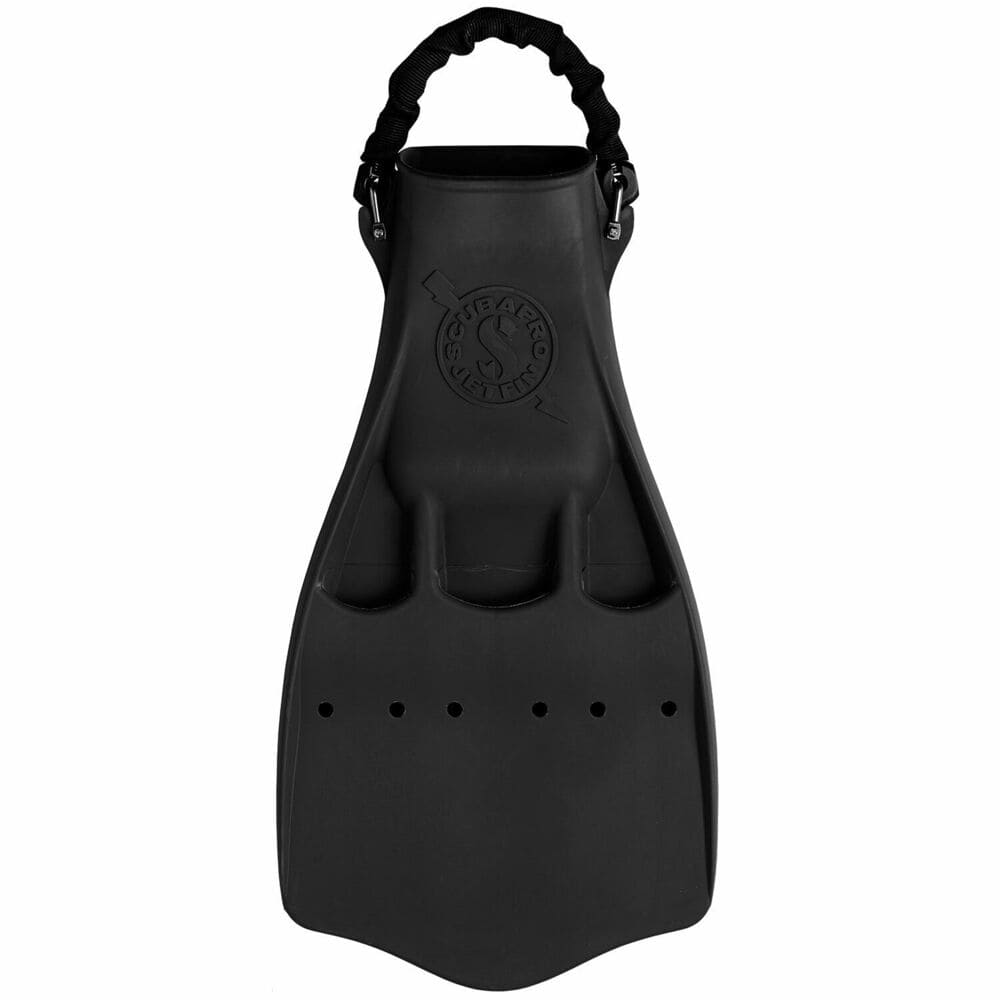
Jet fins have a broad, rectangular blade with a higher stiffness that favors power and precision maneuverability. Consider the following pros and cons of the Jet fin design:
Jet Fin Pros:
- Maximal Propulsion: Jet fins prioritize blade rigidity and surface area to deliver the most thrust and propulsion.
- Maneuverability: They offer more precise maneuverability compared to other fins; especially when combined with techniques like helicopter turn and back kick.
- Future-Proofed: Jet fins are overwhelmingly favored by advanced technical and cave divers.
- Ruggedness: Jet fin designs are typically very long-lasting, with little or no design features that can fail through wear and tear over time.
- Fin Buoyancy Options: Jet fin designs are available in a variety of modern materials that allow the diver to choose negative or neutral buoyancy to suit their individual needs.
Jet Fin Cons:
- Physical Exertion: Stiff and large blades provide greater thrust upon demand but at the cost of higher muscular exertion.
- Advanced Finning Techniques: Jet fins tend to have low thrust efficiency when used with a basic flutter kick. The diver has to create thrust efficiency by learning more advanced fin techniques; such as the frog kick.
- Heavy: Negatively buoyant Jet fins are typically constructed from heavy rubber compounds. Those can weigh a lot more than alternative designs using modern materials.
These robust and highly capable fins are a great choice for divers who are willing to invest time and effort in developing more refined fundamental diving skills. They offer decisive advantages in thrust, precise control, and buoyancy choice. However, gaining any of those advantages requires a more advanced diving skill set.
Split Fins
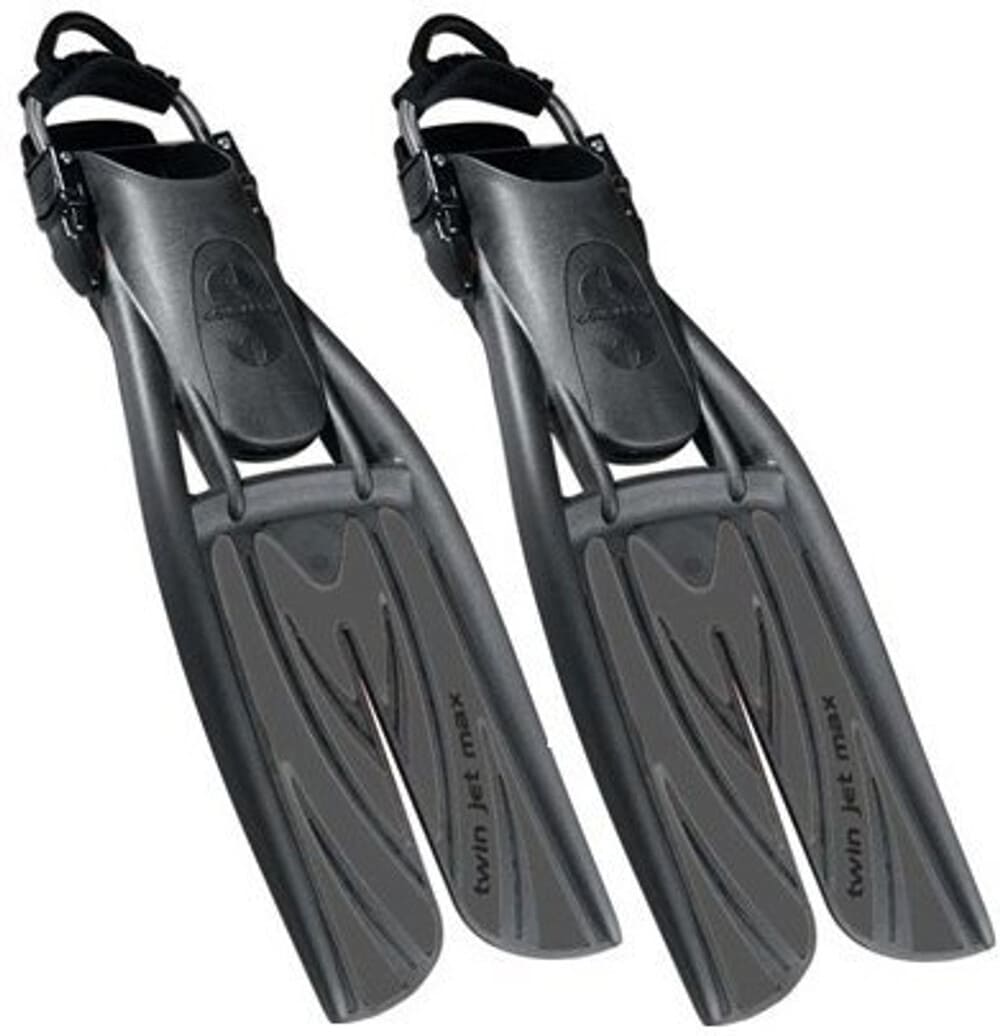
Split fins have a unique design with a split down the middle of the blade. That split simply reduces the functional surface area of the fin blade. In doing so, it diminishes water resistance for the advantage of reduced exertion. Here are the pros and cons of split fins:
Split Fin Pros:
- Reduced Leg Strain: The reduced water resistance corresponds to less effort required when using a flutter kick.
- Compensates For Less Skilled Technique: Split fins minimize cardiovascular and muscular exertion when more refined propulsion techniques are not yet available to the diver.
Split Fin Cons:
- Reduced Power: Split fins may offer less exertion, but the drawback is less power and thrust being available.
- Limited Performance in Strong Currents: Split fins may not provide optimal performance in strong currents or challenging conditions.
- Reduced Maneuverability: The highly flexible blade does not provide a good capacity to make micro-adjustments to your position or orientation in the water.
- Inefficient With Other Propulsion Techniques: Compromising the rigidity of the fin blade significantly reduces the ability to use fine control techniques, such as frog kick, back kick, and helicopter turn.
This design of fins is ideal for divers who value an easier diving experience without the commitment of developing more proficient fundamental skills. They are primarily beneficial for divers with lower physical fitness who suffer more readily from leg fatigue or cramps. Overall, spilt fins trade-off performance capability for ease.
How To Choose the Best Diving Fins For Your Needs
Considerations for choosing the right fin style:
Your Diving Needs and Conditions
- Advanced, technical, cave, and wreck diving: Jet fins are favored by divers engaged in these activities as they prioritize available thrust and fine control maneuvering.
- Infrequent diving, weak fundamental diving skills, or lower physical fitness: If you dive very infrequently or have weaker diving skills and physical fitness, sacrificing fin performance for ease of exertion may be preferable. Split fins, or fins with a small blade area create less water resistance and reduce effort.
The Propulsion Technique You Prefer
- Flutter kick: Split fins are efficient for flutter kick, providing reduced leg strain and better energy conservation. However, they are not as suitable for the frog kick technique.
- Frog kick: Jet or paddle fins offer greater power and control, making them more suitable for the frog kick technique. Split fins are inefficient for this kicking style.
The Need For Maneuverability and Control
- Underwater photographers and videographers: Stiff, wide-bladed, Jet fins offer more fine control of position and orientation in the water and can benefit underwater photographers, videographers, and creature spotters.
- Confined spaces and positional control: Jet fins provide excellent maneuverability due to their stiff and wide blades, making them suitable for navigating tight spaces and accurate positioning in the water.
Diving Fin Power and Speed
- High Thrust Potential: Jetfins provide the most on-demand power and speed, making them suitable for divers who require forceful propulsion, such as in strong currents, technical diving, or against water flow inside caves.
- High-speed underwater travel: Other than dealing with current, surge, flow, or emergencies, scuba divers rarely need to travel underwater at high speeds. Experienced divers often fin slowly so that they notice more interesting things and reduce air consumption.
Which Diving Fin Buoyancy Characteristics Are Beneficial?
- Positive buoyancy fins: May be perceived as less effortful during diving, especially on the hamstrings, and will float if they come loose underwater. They are an advantage for divers who feel foot-heavy underwater.
- Negative buoyancy fins: These are advantageous for divers who have foot-light trim. They are beneficial for drysuit and backmount technical divers.
- Neutral buoyancy fins: These do not contribute either way to the diver’s trim. Sidemount divers using wetsuits typically need neutrally buoyant fins.
Combination with Diving Booties or Drysuit Boots
- Shore dives: Open-heel fin designs are invaluable for divers who conduct shore dives as they permit booties to be worn, providing protection for the feet during water entry.
- Drysuit divers: Most drysuits are sold with integral boots. These require open-heel fins.
Future-Proofing and Return on Investment
- Aspiring advanced skills and specialist diving activities: If you aspire to develop more advanced skills or progress into high-level diving activities like technical, wreck, or cave diving, it can pay dividends to buy an appropriate fin for that end goal.
- Jet fin designs: In general, jet fin designs are the best choice for advanced skill sets and specialist diving activities.
Useful Diving Fin Features
Some diving fins offer additional features that can enhance your diving experience. Here are two additional fin features to consider:
Diving Fin Spring Straps
Spring straps are designed to replace traditional rubber straps on open-heel fins. They offer much easy donning and doffing, even with gloves on, provide a secure fit, and are far more durable. Spring straps are also far less likely to fail during your dive, and they keep the fins very snug on your feet.
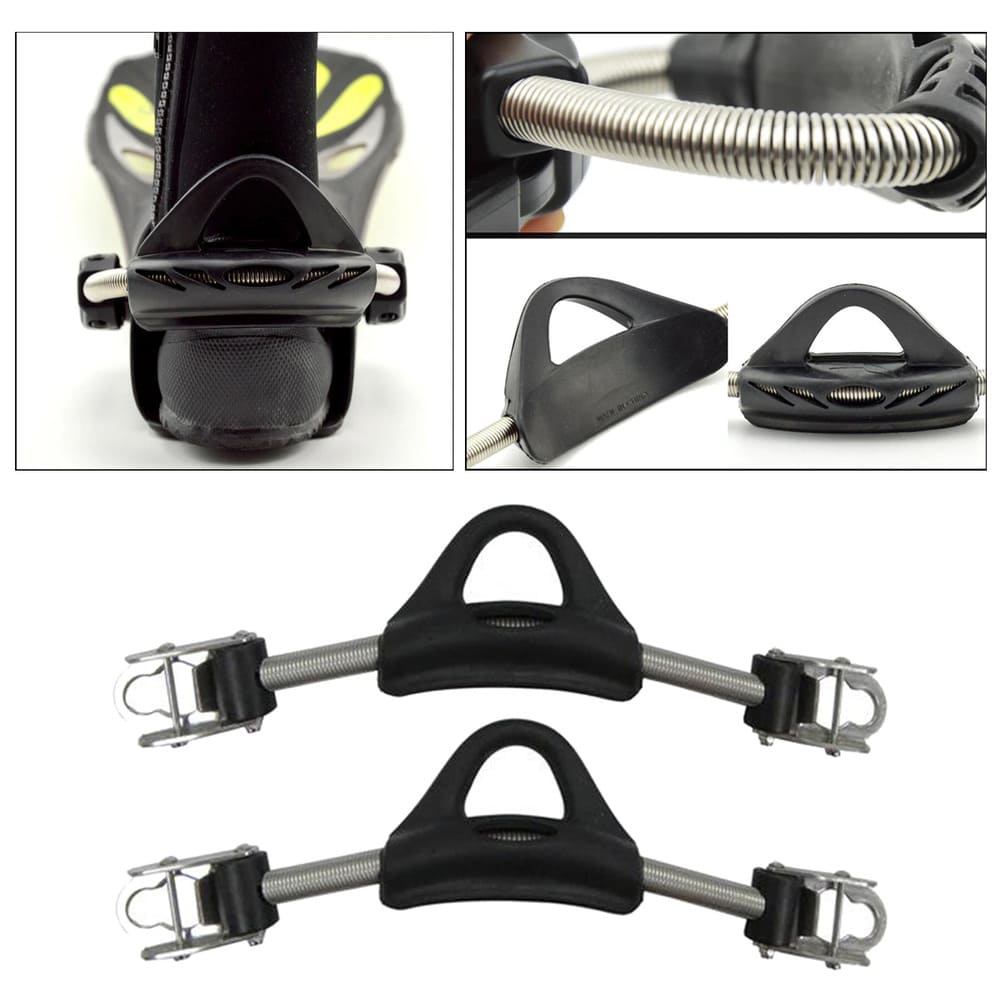
- Pros:
- Easy and quick to put on and take off, even with gloves on.
- Provide a secure and comfortable fit, reducing the risk of fin slippage.
- Durable and long-lasting, offering better resistance to wear and tear compared to traditional rubber straps.
- Cons:
- May require initial adjustment to find the optimal tension for a snug fit.
- Generally more expensive than traditional rubber straps.
These upgraded straps are a popular choice among divers due to their convenience and reliability. They are beneficial for divers who struggle with donning and doffing their fins in the water; especially those who dive in cold water and wear thick gloves.
Spring straps may be included when you initially purchase your fins, or they may be something you can upgrade later on. Generic after-market spring straps are available with a variety of fin attachment type options:
Additionally, some diving fin manufactures sell brand-specific spring straps as an additional cost upgrade to their existing fins. It is a shame they don’t supply them when you buy the fins in the first instance.
Diving Fin Color Options
- Pros:
- High-visibility colors (e.g., bright yellow, orange, or neon) can enhance diver visibility underwater. This improves situational awareness in your dive team and helps avoid buddy separations.
- Some fins offer a variety of color options, allowing you to choose a themed style that matches your personal dive gear preferences.
- Cons:
- Bright colors may fade over time, especially with prolonged exposure to sunlight and seawater.
- Color preferences are subjective and may not be a crucial factor for all divers.
The choice of color in diving fins can play a role in safety and personal style. Opting for high-visibility colors can be particularly beneficial for divers who often dive in areas with low visibility or strong currents, as it helps improve underwater visibility and promotes diver recognition.
By considering these useful features when selecting your diving fins, you can further customize your gear to meet your specific needs and preferences, enhancing both safety and enjoyment during your dives.
Buy The Best Diving Fins With Confidence
In conclusion, selecting the perfect diving fins is a critical decision that significantly impacts your scuba diving adventures. With manufacturers making bold claims and dive gear salespeople vying for your attention, it can be challenging to navigate the sea of options and find the ideal fin choice.
But prepared with the pro insights provided in this article you are well-equipped to make an informed decision.
You can make a confident choice that aligns with your diving needs, future aspirations, and individual preferences. Simply, bear in mind the role of diving fins in scuba diving, grasp their working principles, and consider how fin design and features are suitable for different uses.
So, don’t let the overwhelming dive gear market confuse you. With the right diving fins on your feet, you’ll embark on unforgettable dives, gliding through the depths with ease and confidence. Happy diving!
About The Author

Andy Davis is a RAID, PADI TecRec, ANDI, BSAC, and SSI-qualified independent technical diving instructor who specializes in teaching sidemount, trimix, and advanced wreck diving courses.
Currently residing in Subic Bay, Philippines; he has amassed more than 10,000 open-circuit and CCR dives over three decades of challenging diving across the globe.
Andy has published numerous diving magazine articles and designed advanced certification courses for several dive training agencies, He regularly tests and reviews new dive gear for scuba equipment manufacturers. Andy is currently writing a series of advanced diving books and creating a range of tech diving clothing and accessories.
Prior to becoming a professional technical diving educator in 2006, Andy was a commissioned officer in the Royal Air Force and has served in Iraq, Afghanistan, Belize, and Cyprus.
In 2023, Andy was named in the “Who’s Who of Sidemount” list by GUE InDepth Magazine.
Purchase my exclusive diving ebooks!
Originally posted 2023-06-19 16:09:57.











